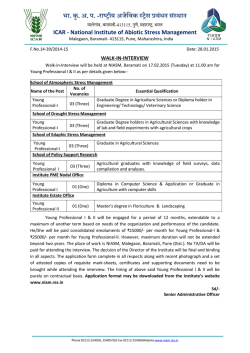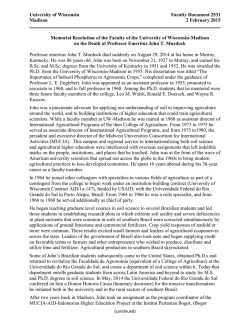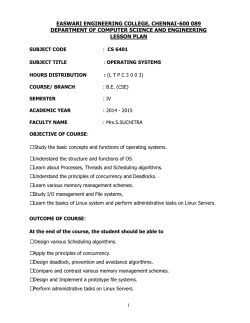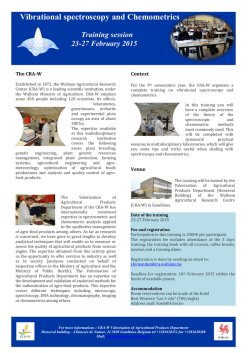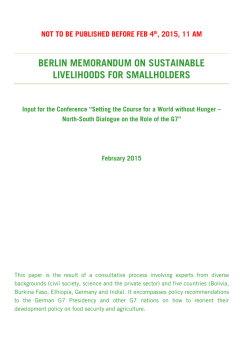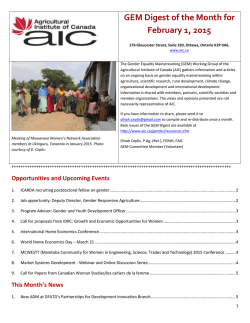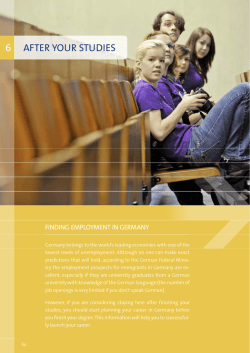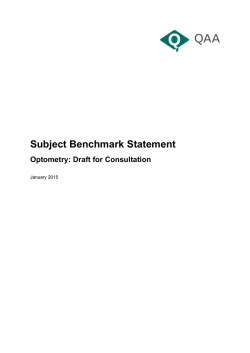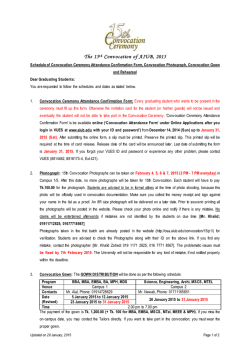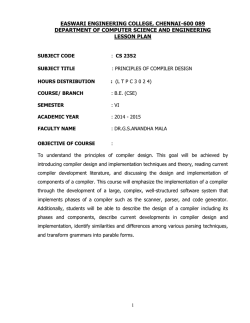
Download (191kB) - Munich Personal RePEc Archive
M PRA Munich Personal RePEc Archive Education and specialized training - ways to increase performance in agriculture Ancuta Marin The Research Institute for Agriculture Economy and Rural Development 20. November 2014 Online at http://mpra.ub.uni-muenchen.de/61725/ MPRA Paper No. 61725, posted 1. February 2015 05:36 UTC EDUCATION AND SPECIALIZED TRAINING - WAYS TO INCREASE PERFORMANCE IN AGRICULTURE ANCUŢA MARIN1 Summary: This paper makes a brief analysis of education in general and of agricultural profile in particular, and highlights existing problems, and the ways to improve them, in order to increase performances in agriculture. The economic development of a country requires transformations qualitative, quantitative and structural, both in economy and how people think. Therefore, there can be no economic development without fulfilling social conditions without changing the institutional framework, without research and education, without technical progress. On Measure the economic development, educational institutions suffer changes of functions, adapting to specific needs of the moment. In traditional societies, education refers to the transmission and reception of knowledge, to the formation of a public opinion, to maintain a broad social consensus. In modern society, the educational institution acquires a special importance, which can be regarded as recruitment agent and the distribution of individuals or group of individuals to different economic roles or positions within the social structure. Because of this, both in developed countries as well as in emerging the education became a variable of profound influence on progress of human society by facilitating economic development. Keywords: education, performance, economic development, professional training INTRODUCTION Education, as a social phenomenon has historical character. She appeared with the first forms of social organization of people and evolved according to the transformations undergone by human society. Education aims to form a personality consistent with the objective requirements of society and the individual. The great Dutch humanist Erasmus said in the seventeenth century that "The future of a nation is determined by how it prepares its youth" perfectly true statement nowadays. Initially education was predominating individual. Moving from the individual to the collective education was made due to the need for schools to keep up with technical progress, to deliver a increasing volume of scientific knowledge in a relatively short time and a increasing number of students required for production development. The economic development of a country requires transformations qualitative, quantitative and structural, both in economy and in how people think. Therefore, there can be no economic development without fulfilling social conditions without changing the institutional framework, without research and education, without technical advance. Because of this, both in developed and in developing countries the education became a variable with profound influence on progress of human society by facilitating economic development. This paper is an analysis of Romanian education compared to that of countries in the European Union, highlighting the problems related on the one hand the lack of specific studies and the disparity between the number of graduates of secondary and higher education and the other hand requirements of the labor market, the performance to be achieved in order to have an efficient economy, made by skilled people. MATERIAL AND METHOD The education system represents the coherent ensemble of schools at all levels, profiles and shapes, from a certain country, which is designed, organized and operated on the basis of educational principles, general organizational character and some with legal character. PhD. Ec. Ancuţa Marin – Economist at The Research Institute for Agriculture Economy and Rural Development, [email protected] 1 Biggest part of education at all levels, profiles and shapes in Romania is organized by state, ensuring that the organization and operation of schools at all levels, profiles and organizational forms in all their sides, content, teaching and assessment. In Romania the first agricultural high schools appeared about 50 years ago, by transforming agricultural vocational schools in agricultural colleges, equipped with agricultural farm schools teaching in which students were required to practice and begins work the best trained high school graduates or faculty experts . In 1990, in Romania there were 160 schools and agricultural colleges. According to statistics, today there are only 40 of them with more than poor equipment. Dilemmas facing high school graduates when they have to choose an institution of higher education are even higher as there are no studies on the demand on the labor market within 3-5 years. In other European countries such reports are ordered by authorities. According to specialists in human resources, the structure of higher education in our country is not aligned with the latest trends in the real market. Most of the times, companies are put in the position of hiring inexperienced staff, case where the company assumes the role of "teacher" for several months after recruitment. Young people today do not really care about college because society no longer values the Romanian education and there are increasingly fewer people working in the field who were trained. Reason for this is the fact that the system is outdated and learning methods are old and the same books as 20-30 years ago are used for learning. Paradoxically, the faculties with little chance of employment after graduation attract more candidates. The most popular specializations on the labor market in 2013 were technical, engineering, automation, cybernetics, all specializations in IT, medicine, pharmaceuticals, foreign languages, because they are well-paid jobs and are popular also in other countries of the Europe, Canada and USA. Top faculty directly sending a large number of unemployed graduates is led by humanities majors - Letters, Philosophy, Sociology, Political Science - followed Journalism, Public Administration and even Economics. The work is based on the study of a vast bibliography on the field, the analysis of the Romanian educational system in general and of the agriculture educational system in particular using statistical data during the period 2006-2013. RESULTS AND DISCUSSION By analyzing and processing the data published by the National Statistics Institute (INS), I made a situation for university graduates in Romania in the period 2006-2013. As shown in Table 1, in Romania, in 2008, there is a doubling of the number of graduates, followed by a slight decrease in the following years. Table 1 HIGHER EDUCATION GRADUATES SITUATION IN ROMANIA FOR STATE + PRIVATE TOTAL DOMAIN 2006 2007 2008 2009 2010 2011 2012 2013 GRADUATES BY DOMAIN 24.605 24.758 23.949 49.342 30.287 25.493 27.190 25.317 230.941 Technical 3.200 3.750 2.087 3.336 2.228 2.453 2.499 2.396 21.949 Agricultural Medico6.292 6.633 6.596 8.122 7.763 9.729 9.434 9.437 64.006 pharmaceutical Economic 32.098 37.211 94.884 67.420 72.641 62.685 34.415 25.724 424.078 sciences 10.175 12.568 14.458 21.418 17.954 26.404 19.215 12.521 134.713 Legal sciences 36.502 42.093 92.118 66.140 60.198 57.507 41.514 33.430 429.502 Pedagogical Artistic and 2.572 2.236 3.880 2.384 2.448 2.629 2.404 2.203 20.756 journalistic TOTAL GRADUATES PER YEAR 112.244 125.499 232.885 214.826 191.291 186.900 136.671 111.028 1.311.344 Source: INS data processing From the data presented follows that 43% of higher education graduates are economists or lawyers, while only 19% fall into the category of directly productive (engineers and farmers). Chart 1 - The situation of graduates from multiannual average 250000 200000 150000 Totalabsolventi graduates/year Total pe an 100000 Media Average 50000 0 2006 2007 2008 2009 2010 2011 2012 2013 Annually, the Romanian education system “produces" on average 163.918 of university graduates. The year 2008 marks the beginning of "explosion" of graduates, which lasts until 2011 From 2012 the number of graduates is comparable to the first part of the period considered, a possible explanation being that drastically reduced the number of those managed baccalaureate. As shown in Table 1 and Chart 2, from the total graduates, the share of those in the agricultural sector is below 3%, which for a modern agriculture is very little. Chart 2 – The situation of graduates with agricultural profile 250000 200000 150000 Total graduates/year Total absolventi pe an Graduates in agricultural profile Absolventi in agricultura 100000 50000 0 2006 2008 2010 2012 Net international migration rate is significant and is primarily related to younger age group constitutes the second cause of decline in the number of university graduates. External migration has become an issue of significant magnitude for Romania, especially in recent years. Statistics estimations indicate that more than 2 million Romanian - or about 10% of the population working abroad (Spain, Italy, Greece and Germany). Young people are not necessarily aware of the deficit of people trained for specialized fields, but rather orientates towards universities considered to be good. That's because they think the higher the chances that you might have when you exit on labor market. As shown in Table 2, in the last five years has increased the importance of training of persons active in all EU countries the weightings they occupy educated population in total population in a country, varying very little, but an upward trend. Table 2 PROPORTION OF PEOPLE WITH HIGHER EDUCATION IN TOTAL POPULATION 2009 2010 2011 2012 2013 COUN TOTAL TRY POPULATION * ** * ** * ** * ** * ** Germany 81.802 11.940 France 65.822 10.359 U.K. 62.008 11.774 Italy 60.626 5.044 Spain 46.149 8.537 Poland 38.187 4.763 Romania 20.122 1.689 Holand 16.945 3.086 Hungary 10.014 1.145 Sweden 9.428 1.667 Austria 8.404 898 Denmark 5.561 950 Finland 5.461 1.090 Slovakia 5.435 526 Source: EUROSTAT data processing 14,60 15,74 18,99 8,32 18,50 12,47 8,39 18,21 11,43 17,68 10,68 17,09 19,96 9,68 12.060 10.501 12.402 5.141 8.848 5.018 1.789 3.032 1.166 1.716 917 969 1.117 591 14,74 15,95 20,00 8,48 19,17 13,14 8,89 17,89 11,64 18,20 10,91 17,43 20,46 10,87 12.610 10.730 13.106 5.211 9.105 5.233 1.946 3.041 1.227 1.770 929 977 1.144 636 * ** 15,42 16,30 21,14 8,60 19,73 13,70 9,67 17,95 12,25 18,77 11,05 17,56 20,96 11,70 12.961 11.118 13.675 5.481 9.265 5.519 2.030 3.113 1.277 1.832 966 998 1.149 660 15,84 16,89 22,05 9,04 20,08 14,45 10,09 18,37 12,75 19,43 11,49 17,94 21,05 12,14 13.154 11.499 14.078 5.683 9.463 5.770 2.071 3.164 1.304 1.918 1.004 1.012 1.171 687 People with higher education % from total population During the last decade, lifelong learning has occupied a central position in the Community policy on the education and training. Adult education has been recognized as an important component of lifelong learning, adult learning opportunities is essential to the social and economic progress, and personal development. Lifelong learning in Romania is not dealt in a coherent and comprehensive system and educational policies. This limits the consistency and flexibility of individual learning routes lifelong. Despite progress in regulating the validation of prior learning, insufficient use of the existing legal framework remains one of the weaknesses of the process of introducing the approach of "lifelong learning" in education and training. Insufficient development of knowledge transfer mechanisms, limits the possibilities of the population, especially the adult population, to obtain formal accreditation of competences acquired in the labor market and to rejoin the formal education system. Also in the policy making is a need for greater coherence between policies in education, vocational training and continuous professional training. The validation of knowledge acquired a better correlation between education and initial vocational training and continuing vocational training, improving the definition and transparency of qualifications are issues addressed in the development and implementation of the National Qualifications Framework. The Sectoral Operational Programme Human Resources Development (POSDRU) establishes priority axes and areas of intervention of Romania in human resources to implement the financial assistance of the European Union. Investments in human capital will complete and will give long-term sustainable productivity growth. A highly skilled manpower with a high level of education, having the ability to adapt to new technologies and the changing needs of the market is essential for a competitive and dynamic economy. In the category of adult training also enters the acquisition of information and knowledge to enable sustainable management of agricultural and forestry land, improve management quality at farm level, restructuring and modernization of the processing and marketing sectors for agricultural and forestry products, contributing thus to improving living conditions and reducing unemployment in rural areas. These actions are set out in Measure 111 - "Training , information and diffusion of knowledge" from the National Rural Development Programme 2007-2013 respectively measure 1 "Knowledge transfer and information actions" National Rural Development Programme 2014-2020. 16,08 17,47 22,70 9,37 20,51 15,11 10,29 18,67 13,02 20,34 11,95 18,19 21,44 12,63 In National Rural Development Programme 2014-2020, the amount allocated for knowledge transfer and information actions is 50 million. Such financial instruments, which will be available for Romania, will not be valued unless there is research reformed if there is a system of professional education adapted to the needs in practice, if there is a relationship between the young man who wants to take a farm or to work in an agricultural society, the basic training system, continuous training system. CONCLUSIONS With the development of agriculture, "based on EU funds" there is a increasingly higher demand for employment in agriculture. Better cooperation between the Ministry of Agriculture and Rural Development, Ministry of Education, Ministry of Labour and Social Safety, Employment Agencies and agricultural colleges and universities in the field in order to establish relevant schooling figures for the "production" of specialists to be absorbed by the labor market should be a priority in the near future. Another way to increase the economic performance of the country in general and agriculture in particular, is the initiation of technical working groups between the Ministry of Agriculture and Rural Development and Ministry of Education - the complete strategy on identifying new skills required labor market, development of new training standards, updating and revision of the Code of Occupations in Romania and Nomenclature of Qualifying. The link between education and training continues to be well understood and promoted. Another priority should be the the reestablishment of didactic farms where students in agricultural colleges and universities in the field to be received and directed to acquire practical knowledge needed to successfully practice their future professions. Ministries must identify forms of support for agricultural education graduates and to organize information and promotion campaigns regarding agriculture. BIBLIOGRAPHY 1. 2. 3. 4. 5. 6. Bontaş, I. - Pedagogy, ALL Publishing House, Bucharest, 1994 Cicea Claudiu, Dobrin Cosmin - The contribution of education to economic development, ASE Publishing House Bucharest, 2005 http://www.cnp.ro/inovatie/docs/seminar-studii-25-06-2012/Rezumat%20studiu%20Piata%20muncii.pdf http://www.insse.ro/cms/files/pdf/ro/cap23.pdf Palicica Maria, Gavrilă Codruţa, Ion Laurenţia - Pedagogy for agricultural education Mirton Publishing House, Timisoara, 2007 Ziarul Financiar, Recolta.eu – agribusiness daily newspaper
© Copyright 2024
